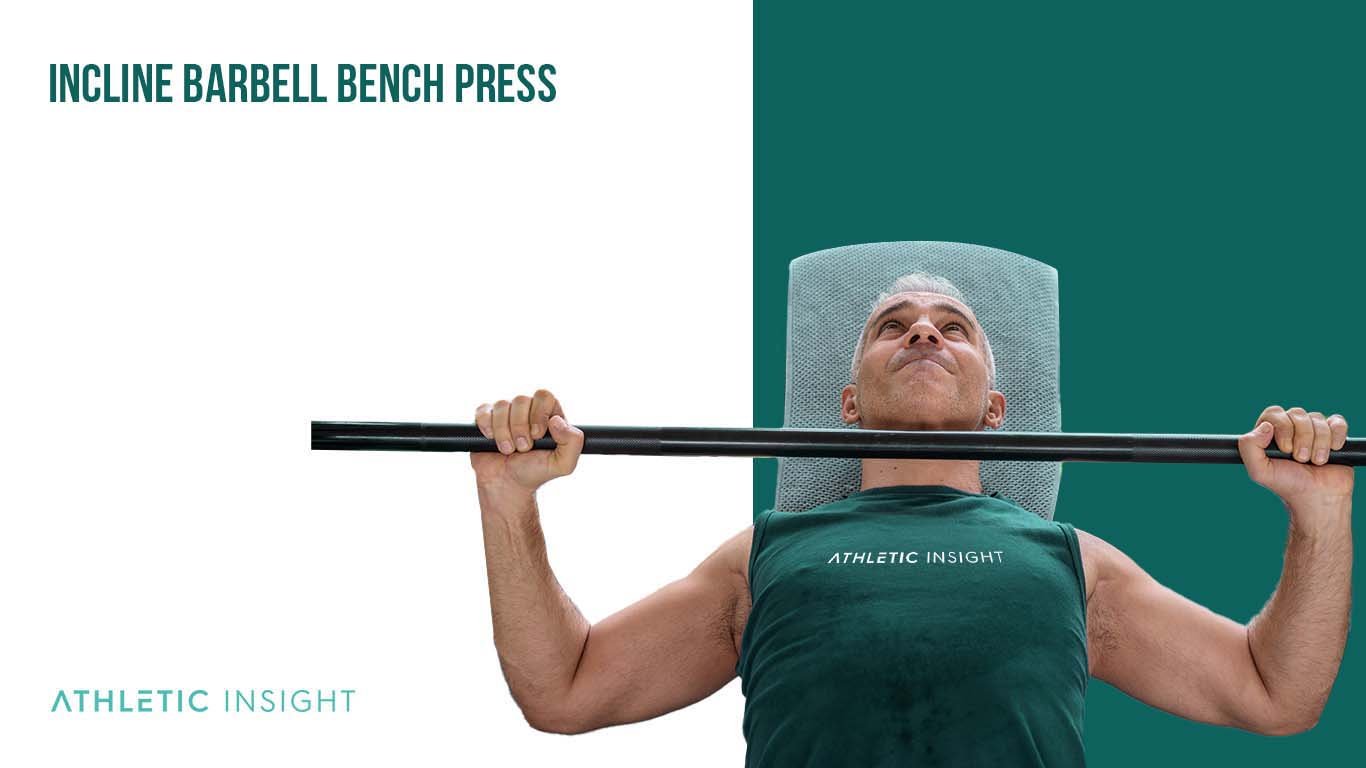The incline bench press is a pushing motion that activates your pectoral muscles, deltoids, core, and quadriceps to push a barbell away from your chest. The incline bench can activate the pectoral muscles to a different degree than if you were using a flat bench, making this a good choice for bodybuilders and weightlifters who need to build their entire pectoral muscles (pectoralis major and pectoralis minor).
The inclined bench press typically focuses on the pectoralis major, the upper part of your chest, the anterior deltoid, and the triceps. The incline bench press is necessary for building chest strength, developing power during the pushing motion of the exercise, and building complete upper body strength.
This compound exercise is a good choice for classic weightlifting, Strongman competitions, bodybuilding, and athletes who focus on upper-body power and range of motion. Other weight-related variations exist for those who need to build other muscles in the chest (pectoralis minor), posterior deltoid, and the biceps.
Pulling motions can be used with the pushing motion of the inclined bench press to supplement the push-pull and balance the body. The best variations to use for the inclined bench press include the flat bench press, dumbbell bench press, incline bench cable press, bent-over row, barbell bent-over row, chest-supported dumbbell row, and chest machine press.
This exercise is not suitable for beginners unless they use lightweight dumbbells. Beginners should start with the flat bench press first, pushups, and other machines before using the incline bench press with the barbell.
1. Flat Bench Press
The flat bench press is an inclined bench press variation that focuses on the pectoralis major, pectoralis minor, triceps brachii, anterior deltoids, trapezius, and back muscles. The flat bench press is a good exercise for athletes, bodybuilders, and weightlifters who want to build upper body strength and power.
Alternatives to the flat bench press include the incline bench press, incline barbell bench press, incline dumbbell bench press, flat dumbbell bench press, and pushup. One mistake that users need to avoid while doing this exercise is to arch the lower back. Users can prevent this mistake by focusing on their proper grip width and keeping their elbows at a 90-degree angle during the push.
The toughness level of this exercise is a 5 out of 10 since it can be taught properly and used with a lighter weight to avoid any strain on the shoulders, chest, or wrists.
2. Incline Barbell Bench Press
The incline barbell bench press is an inclined bench press variation that focuses on the pectoralis major, anterior deltoids, triceps brachii, and trapezius. The incline barbell bench press is a good exercise for bodybuilders and weightlifters who want to focus on building the front of their shoulders and the pectoralis major, the upper portion of their chest.

Alternatives to the incline barbell bench press include the flat bench press, incline dumbbell bench press, decline pushup, incline pushup, cable chest press, and chest supported row. One mistake that users need to avoid when doing the incline barbell bench press is not going through the full range of motion. Users should keep in mind to bring the bar down to their chest and push it straight upwards, not outward.
The toughness level of this exercise is 6 out of 10 since balancing the barbell is tougher than dumbbells, and the incline bench makes it harder to keep the bar in the right path above your chest.
3. Incline Dumbbell Bench Press
The incline dumbbell bench press is an inclined bench press variation that focuses on the upper chest, the pectoralis major, the anterior deltoids, and the trapezius. The dumbbell bench press is a good choice for bodybuilding weightlifters who want to build the upper chest on the front of their shoulders.
Alternatives to the incline dumbbell bench press include the flat dumbbell bench press, flat barbell bench press, incline barbell bench press, close grip incline bench press, and chest press machine.
One mistake that people need to avoid during the incline dumbbell bench press is not to bring the dumbbells down for the full range of motion. Users can prevent this mistake by following two tips: keeping their elbows at the right angle to their body and their palms facing downward during the entire motion.
The toughness level of this exercise is a 5 out of 10 since it can be easier to control the dumbbells than the barbell during the incline bench press.
4. Close Grip Incline Bench Press
The close-grip incline bench press is an inclined bench press alternative that focuses on the upper chest, anterior deltoids, and trapezius muscles. The close-grip incline bench press is a good choice for bodybuilders and weightlifters who want to focus more on the triceps than the chest muscles.
Alternatives to the close grip incline bench press include the incline dumbbell bench press, close grip dumbbell bench press, close grip barbell bench press, tricep pushdown, and tricep overhead extension. One mistake to avoid is bringing your hands to offer out on the bar. Users can sidestep this mistake by keeping their elbows tight to their bodies and keeping the grip closer than they would with the regular incline bench press.
The toughness of this exercise is a 6 out of 10 since it requires a focus on the triceps instead of the chest.
5. Wide Grip Incline Bench Press
The wide grip incline bench press is an inclined bench press variation that focuses on the sternal and vascular heads of the pectoralis major, anterior deltoid, and triceps. This wide grip bench press is a good choice for weightlifters and bodybuilders who want to tax the outside of their chest.

Alternatives to the wide grip incline bench press are the close grip incline bench press, wide grip flat bench press, chest fly, chest supported fly, and dumbbell bench press. Users need to avoid moving their grip in during the motion of the press. Users can sidestep this mistake by gripping the bar at a wide-angle and pushing straight upwards instead of outward.
The toughness of this exercise is a 7 out of 10 due to the wide grip making it harder to move heavyweight.
6. Incline Dumbbell Crush Press
The incline dumbbell crush press is an inclined bench press variation that focuses on the chest and triceps, activating the pectoral muscles as you squeeze the weights together during the pushing motion of the exercise. This incline dumbbell crush press is suitable for weightlifters and bodybuilders.
Alternatives to the incline dumbbell crush press are the incline dumbbell chest press, incline barbell chest press, chest fly, chest machine press, and decline dumbbell chest press. Users need to avoid bringing the weights apart during the push motion. Users can avoid this mistake by focusing on squeezing their pectoral muscles and choosing a lighter dumbbell weight.
The toughness of this exercise is a 7 out of 10 since it takes mental focus to keep the weights together during the motion.
7. Dumbbell Neutral Grip Incline Bench Press
The dumbbell neutral grip incline bench press is an inclined bench press alternative that taxes the upper chest, shoulders, and triceps. The natural grip can help reduce shoulder strain and focuses more on the triceps than the regular chest press. This workout can be good for bodybuilders and weightlifters who want to focus more on the back of their arms than their chest and shoulders.
Alternatives to the dumbbell neutral grip incline bench press are the dumbbell incline bench press, barbell bench press, barbell incline bench press, dumbbell overhead press, and dumbbell overhead extension. One mistake to avoid is to flare your elbows out during the movement. Users need to focus on keeping a neutral grip and elbows close to their bodies.
The toughness of this exercise is a 5 out of 10 since users can use a lighter weight and still reap the triceps benefits.
8. Alternating Dumbbell Incline Bench Press
The alternating dumbbell incline bench press is an inclined bench press variation that focuses on the triceps, pectoral muscles, and anterior deltoid muscles on the front of your shoulders. The alternative press can be good for athletes to remove any inconsistencies in single-arm strength in their bodies.
Alternatives to the alternating dumbbell incline bench press are the dumbbell incline press, alternating flat bench dumbbell press, alternating dumbbell row, chest machine press, and pushups. One mistake to avoid is to raise and lower the weights inconsistently. Users can avoid this by focusing on their breathing and keeping their elbows close to their bodies.
The toughness level of this exercise is a 6 out of 10 since it takes more coordination and core strength to keep the weight stabilized at the top of the motion.
9. Top-Down Alternating Incline Dumbbell Bench Press
The top-down alternating incline dumbbell bench press is an inclined bench press variation that focuses on the clavicular head of the pectoralis major, the anterior deltoids, and the triceps brachii. This exercise works well for bodybuilders, beginners, weightlifters,s and athletes who want to build their upper body strength and stability.
Alternatives to the top-down alternating incline dumbbell bench press are the alternating dumbbell bench press, alternating flat bench dumbbell bench press, incline barbell bench press, flat bench barbell bench press, and altering single-arm dumbbell row. Users need to avoid moving the weights at the same time. Users should keep in mind to keep the weights directly over their chest and to bring the weight through the full range of motion.
The toughness level of this exercise is a 6 out of 10 since it requires extra stabilization.
10. One and One Quarter Incline Barbell Bench Press
The one and one quarter incline barbell bench press is an inclined bench press variation that focuses on the pectorals and triceps. Bodybuilders and weightlifters should use this exercise to build their pectoral muscles and treat their stability and muscular endurance.
Alternatives to the one and one quarter incline barbell bench press are the incline barbell bench press, one and one-quarter flat bench barbell bench press, one and one quarter dumbbell bench press, and one and one quarter incline dumbbell bench press users need to avoid going through the motions too quickly. Users can avoid this mistake by counting to themselves and breathing through the range of motion.
The toughness level of this exercise is 7 out of 10 due to the stability and timing required.
11. Hammer Strength Incline Machine Press
The hammer strength incline machine press is an inclined bench press variation that focuses on the pectoralis major, anterior deltoid, and triceps brachii. This exercise is suitable for bodybuilders and weightlifters who want to use a machine or beginners who do not know how to use free weights.
Alternatives to the hammer strength incline machine press include the dumbbell incline press, dumbbell flat bench press, barbell incline bench press, and barbell flat bench press. One mistake to avoid during the hammer strength is to bring your head off of the back support. Users can avoid this mistake by keeping their back and head on the support and elbows close to their bodies.
The toughness level of this exercise is a 4 out of 10 since the weights are on a track and your back and head are supported.
What Are the Main Incline Bench Press Exercises Variation Types?
There are various incline bench press exercise variation types, such as supported versions, machine variations, barbell options, dumbbell options, and cable choices.

Which Type of Inclined Bench Press Exercises Variation is Good For Beginners?
Beginners should use the hammer strength incline machine press or machine chest press.
Which Type of Inclined Bench Press Exercises Variation Is Good for Weightlifters?
The best bench press exercise variation for weightlifters includes the incline barbell bench press and flat bench press.
Which Type of Inclined Bench Press Exercises Variation Is Good for Athletes?
Athletes should use the flat bench press, incline dumbbell bench press, and alternating dumbbell incline bench press to work their stability.
Which Type of Inclined Bench Press Exercises Variation Is Good for Bodybuilders?
Bodybuilders should use the incline dumbbell bench press, incline barbell bench press, wide grip incline bench press, and dumbbell neutral grip incline bench press as bench press exercise variations.
Which Type of Inclined Bench Press Variation is Difficult to Perform?
The most difficult exercises to perform instead of the inclined bench press are the close grip incline bench press, wide grip incline bench press, alternating dumbbell incline bench press, and one and one quarter incline barbell bench.
Are There Similarities Between Incline Bench Press and Dumbbell Bench Press Variations?
There are similarities between the incline bench press and dumbbell bench press variations. Both exercises work for the same muscle groups and use the same pushing motion.
What are the different Incline Bench Press Alternatives?
If you are looking to switch from an incline bench press to another exercise, the decline bench press, dip and cable crossover are effective choices. These are only some of the many incline bench press alternatives that a weightlifter can perform.



